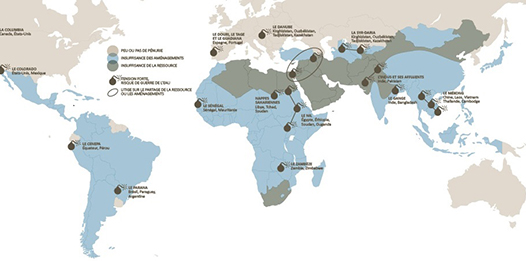
ANALYSIS – Author of several works on the geopolitics of water, Franck Galland comments on the map of water-related tensions taken from David Blanchon’s Atlas Mondial de l’eau (World Water Atlas), published by Autrement.
A CATALYST FOR CONFLICT
As the map demonstrates, there is a diagonal “thirst line” stretching from Gibraltar to North-East China, which suffers from tremendous water stress as well as tensions caused by a lack of surface water. A person living along this axis has at his or her disposal an average yearly reserve of less than 500m³ of water. Below this threshold, the economic and social development of the country in question is seriously jeopardised. In these regions, water is a catalyst for conflict, alongside other causes: ethnic, religious, political or economic.
TENSIONS LINKED TO WATER RESOURCES
Water wells are often at the source of clan wars, particularly in Yemen. Its capital, Sanaa, has limited water reserves: only 120m³ per person, per year. None of the wars currently being fought in the world can be attributed to water alone. However, there is a risk of violent frontier conflicts, particularly between Egypt and Ethiopia. The construction of the Renaissance dam in Ethiopia, scheduled for completion in 2017, will create the greatest reserve of fresh water in Africa. It will also reduce the flow of the Egyptian Nile, which provides 98% of the water consumed in the country. The Egyptian government is unlikely to accept this. Jordan is another example of a situation which must be carefully monitored. For the moment, it is among the most stable zones in the Middle East. The city of Amman hosts the most refugees of any city in the world. To supply it with water, fossil water is extracted from the underground aquifer at Disi, which lies 400km away. Transporting this water incurs significant energy costs in a country which is cruelly lacking in fossil fuels.
TENSIONS LINKED TO POLLUTION
The contamination of water by industrial pollutants is also a cause of regional tensions. In 2005, the explosion of a chemical plant in China resulted in the pollution of the river Songhua which flows into the river Heilongjiang (called the river Amur in Russia). The accident obliged the riverine towns to temporarily suspend the supply of water to 3.8 million people and caused significant diplomatic tensions between the two countries.
CLIMATE REFUGEES
The term “climate refugees” does not only refer to coastal populations forced to flee rising waters: it includes those who lack access to water. By 2025, 4 billion people will suffer water stress, compared with 400 million in 1995. In Yemen or in Somalia, for example, scarcity of water will likely create climate refugees. A similar situation may arise in Syria and Libya, where water supply was already a sensitive issue before civil war broke out.
INVESTMENT AS A SURVIVAL STRATEGY
Despite all these problems, there is hope. Those countries which invest in water supply infrastructure manage to cope. Algeria is a good example: it set out with a serious handicap, due to the civil war of the 1990s and years of under-investment. China is also among those states which manage to find solutions (such as water diversion and desalination), despite rapid demographic growth and a scarcity of water resources in some regions.
Biography : FRANCK GALLAND has a degree in international affairs from the Ecole Supérieure de Commerce de Marseille. A recognised expert on water-related security issues, he is the author of two noted works: L’eau: géopolitique, enjeux, stratégies (CNRS Editions, September 2008) and Eau & conflictualités (Editions Choiseul, January 2012).
